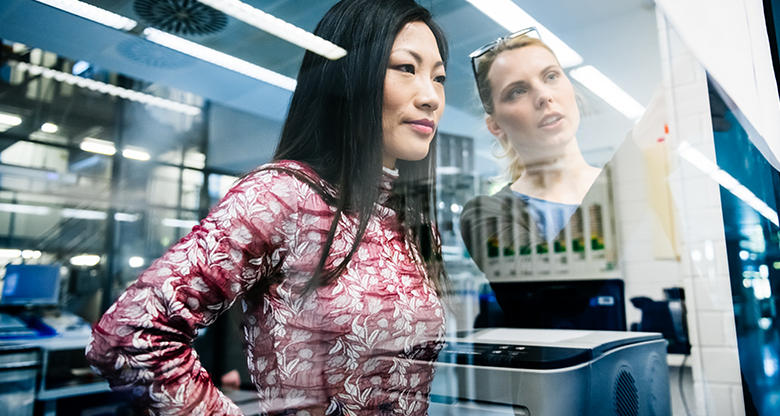Design Thinking is a collaborative approach to a problem solving, that challenges assumptions, emphasises engagement and learning, and reframes problems. People-centred design thinking is even more effective as it helps businesses truly understand their users and clients and results in innovative solutions.
A recent study shows the use of design thinking has risen across a range of industries since 2015. It’s grown 140% in manufacturing, 86% by finance and insurance and a staggering 250% in human health1.
Clearly, it’s an effective process. But design thinking isn’t new. So what’s behind the renaissance?
Access to data and ecosystems fuel design thinking’s resurgence
James Bush is Design Lead, Emerging Technology at CommBank. He says the pandemic revealed for many businesses that they could deliver products and services faster. Now, he says, many are taking a step back to truly understand the customer and consequently, how they can deliver more efficient products and services to them.
The design thinking process allows businesses to translate customer insights into action to provide a better customer experience. And, says Bush, there’s never been a better time to find out what customers truly want and need thanks to a surge in the digitisation of customer service.
For instance, he says about 80% of customers who have the CommBank app open it on a daily basis. “So you've got this really sticky platform, where we can talk to customers, but talk to them in a way where we're providing utility.”
The other factor that’s making design thinking so relevant in business decision making and strategy is technology and the opportunities it creates by connecting ecosystems.
For example in CommBank’s case, the bank creates multiple services and products connecting customers, branches, digital proposition, teams and market segments. To provide solutions within such a diverse ecosystem requires the collaboration of varied thinkers coming together in one place, sharing and challenging ideas and moving beyond biases.
"That might mean bringing in people who might only work with one or two different departments, or even in isolation,” says Bush. “To really ensure that if we're going to try and solve some of these bigger, more wicked problems, we do it with the right people in the room rather than making lots of assumptions.”
The six-stage process of Design Thinking2
- Empathise – build a deep understanding of customers and their needs.
- Define – create a clear outline of any identified issues.
- Ideate – creatively brainstorm and note down ideas.
- Create a prototype – come up with potential solutions.
- Test assumptions – check that the solution is what the customer expects and needs.
What makes the process so successful?
Jeanne Liedtka is professor of Business Administration at the University of Virginia’s Darden School of Business. She believes design thinking gets successful results because it deals with the roadblocks to innovation by:
- Providing better solutions through asking more original questions and getting data from the customer rather than the designers.
- Reducing risk and costs by providing several options to solve a problem.
- Getting employees to back the idea by making them part of the design process.
Liedtka also notes that design thinking follows a structured, repeatable process. This helps design teams stay on task – and provides them with a sense of safety.
“Most humans are driven by a fear of mistakes, so they focus more on preventing errors than on seizing opportunities,” she explains. “They opt for inaction rather than action when a choice risks failure. But there is no innovation without action - so psychological safety is essential.”
Case study: How Airbnb uses design thinking
Bush cites Airbnb as a good example of a business that has adjusted its model to meet customer needs. During the pandemic, the company was forced to find a new way for hosts to generate an income as lockdowns and border closures shut down swathes of domestic and international travel. Airbnb turned itself into the go-to guide for local knowledge as people were limited to travel much closer to home.
“Airbnb became this local guide … showing you all things you can do in a region whether that's restaurants or going for a hike - just all that local knowledge,” explains Bush.
By using design thinking to recast its business model, Airbnb was able to operate during the pandemic. It also helped the business reconnect to its brand purpose: to create a world where anyone can belong anywhere3.
Bush believes this motivation to connect to their purpose and truly serve their customer is another reason why design thinking is enjoying its current renaissance among leading businesses.
“We are now thinking a lot more future-forward about how we can anticipate what our customers are going to need. How can we make things better for our customer? That's how we're trying to think about it.”
Our Design Thinking experts
James Bush leads the design pillar of the Emerging Technology team at CommBank. His team focuses on translating insights gathered from human-centered research into actionable innovation opportunities that unlock and deliver unexpected value for the bank and its customers. His team works across a diverse ecosystem of stakeholders including other financial institutions, strategic technical partners, academia, government organisations, consulting firms and the global start-up community. Prior to CommBank, James worked for Fjord, a design and innovation consultancy that is part of Accenture Song. James is also a guest lecturer and mentor to a range of academic institutions and education not-for-profits.
Jeanne Liedtka is former chief learning officer at United Technologies Corporation and a faculty member at the University of Virginia's Darden Graduate School of Business. She formerly served as associate dean of the MBA program and as executive director of the Batten Institute. She is passionate about exploring how organisations can engage employees at every level in thinking creatively about the design of powerful futures. Jeanne is author of numerous books including Experiencing Design: The Innovator's Journey, with Karen Hold and Jessica Eldridge, How You Can Lead Extraordinary Growth, which won the BusinessWeek best innovation books of 2009; Designing for Growth: A Design Thinking Tool Kit for Managers winner of the 1800 CEO READ best management book of 2011, and its accompanying field guide, The Designing for Growth Field Book: A Step by Step Guide.
To learn more from leading industry experts about what’s important to business and the economy, head to CommBank Foresight™ – insights for future-facing businesses.




